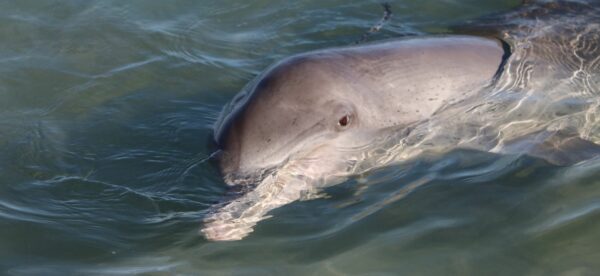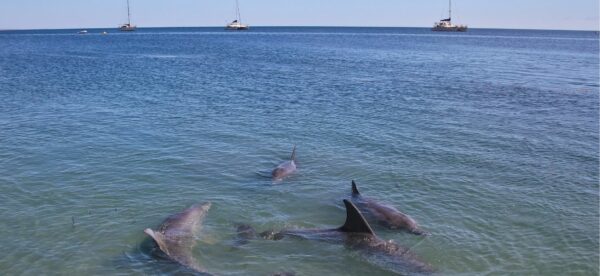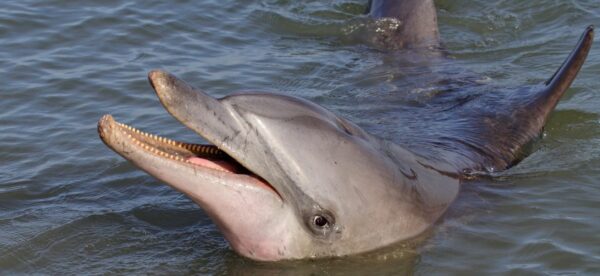The Monkey Mia dolphin feeding program isn’t good for the dolphins who are involved. The Monkey Mia dolphin feeding program, and similar programs around the world, has been shown to negatively alter dolphins’ behaviour, reduce maternal care for calves, cause aggression among dolphins, reduce their home range, and increase the risk of injury to dolphins from boat strikes and entanglements.
Is Monkey Mia good for dolphins?

What are dolphin feeding programs?
Imagine you’re swimming in the wild, going about your day with your pod, when a person encourages you to come to the shore and offers you a meal, no strings attached. It might seem like an offer too good to resist. But what if the free meal comes with unintended consequences?
That’s the scenario faced by wild dolphins in dolphin feeding programs. These programs involve enticing dolphins with food, slowly getting them accustomed to human presence, and in time dependent on humans. It’s dangerous because it entices wild dolphins into a system that significantly disrupts their natural way of life.

“With pervasive damage to the ecosystem and few signs of recovery, extreme caution is warranted with any plan to recruit more dolphins”
Janet Mann et al., 2021
Dolphins beg for food
Feeding wild dolphins has led to dolphins exhibiting unnatural behaviours. Instead of hunting and roaming the open seas, they’ve been known to patrol the waters close to boats, scavenging for leftovers, and begging for food.[1] In Bunbury and Monkey Mia Western Australia, dolphins who are fed now approach boats and beg for food.[2] Remember, every tossed treat encourages this pattern, robbing them of their inherent, wild nature.

Impacts the mother and calf bond
Research shows that when dolphins at Monkey Mia are fed by humans, they pay less attention to their offspring. These young dolphins spend less time in the protective space beneath their mother’s belly, a position typically associated with infant care, and instead are found more often at a distance from their mothers. This change in behaviour suggests that human feeding can unintentionally disrupt the natural mother-calf bonding process in dolphins.[3]

Reduces dolphins' home range
Instead of swimming far and wide, dolphins fed at Monkey Mia now linger close to the feeding sites, waiting for handouts. Their world has become significantly smaller, limiting where they socialise and feed. It’s not just these fed dolphins who are affected. Their young ones, although not fed directly, end up inheriting this confined lifestyle, learning to stay within these restricted boundaries as they mirror their mother’s behaviour. This reliance on hand-fed fish is more than just a change in diet; it’s a shift that carries potential risks to their social dynamics and even survival. After all, a smaller world is not necessarily a safer one, especially for the dolphins of Monkey Mia. [4]

Increases risk of injury to dolphins
Problematic behaviours, particularly begging, increases the risk of dolphins being harmed by a boat strike or fishing gear.[5] In Monkey Mia, the fish hand-out site is located near a boat launch area. This exposes the dolphins to constant boat traffic – increasing their risk of injury.[6]

Increases pressure on their survival after extreme weather events
Smaller home ranges means the dolphins at Monkey Mia have a constrained ability to respond to ecological changes. This was observed following a severe marine heatwave in 2011. The scientists who studied the impact of this event say in their paper that wild dolphin feeding “… has marked impacts on dolphin activity, ranging behaviour and habitat use, with long-lasting maternal effects, thereby constraining the provisioned dolphin’s ability to respond to dramatic ecological changes caused by extreme climate events.” [7]

Increases aggression
In Monkey Mia, male dolphins have become aggressive towards other dolphins and humans. As a result, they have been excluded from the feeding program since 1989.[8]

The Monkey Mia dolphin feeding program
Monkey Mia reserve is located in the Shark Bay Heritage Listed site in Western Australia.
The Monkey Mia feeding program is run by the Western Australian Department of Biodiversity, Conservation and Attractions.
There are currently only two dolphins remaining in the dolphin feeding program at Monkey Mia.
Initially there were five adult dolphins being fed as part of the program. Sadly, between 2018-2019 three of the five dolphins disappeared and are presumed dead.
In January 2022, the Western Australian Government announced plans to entice new dolphins into the feeding program. No reason was given – but we suspect it is to drive more tourism to the area.

Clara Nila via Getty Images
It is illegal for members of the public to hand feed dolphins in Australia, because the Government recognises there are environmental, health and safety concerns associated with feeding dolphins.
Despite this, four tourism sites in Queensland and Western Australia have exemptions to run dolphin feeding programs. Monkey Mia is one of these places.

S Porter via Getty Images
At Monkey Mia, feeding wild dolphins began in the 1960s but it wasn’t until 20 years later researchers discovered calves of these dolphins were dying. 90% of the calves had failed to reach adulthood.
Specific protocols were brought in, and later modified, to try and lessen the impact on calf mortality. A study identified that the protocols have only partially addressed the negative effects of food-provisioning, with “behavioural development” between mother and calf still being affected.
In 2019 Monkey Mia initiated a recruitment drive to increase the number of dolphins participating in their wild feeding program. The number of visiting dolphins at the time had dropped to just two adults, after three regular dolphins had gone missing (presumed dead).
The latest research from Janet Mann et al., is concerning. Their results show that hand-fed females in Monkey Mia have small home ranges compared to non hand-fed females – this is because they are staying near the fish hand-out sites.

Mogens Trolle via Getty Images
In January 2022, a spokesperson from the Department of Biodiversity, Conservation and Attractions said that plans were currently being reviewed to increase the number of dolphins participating in the Monkey Mia dolphin feeding program. We understand this review has not been made public.
What seems like a harmless act of feeding the dolphins has profound implications. It might be hard to see, but every fish handed over doesn’t just feed a dolphin—it reinforces a lifestyle that limits their lifestyle, relationships, adaptability and resilience. Let’s keep our dolphins wild, free, and ready for whatever nature has in store. Sign the petition to help break this cycle for Monkey Mia dolphins.





